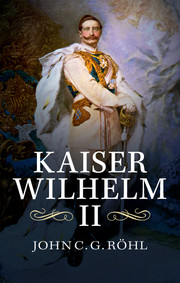Book contents
- Frontmatter
- Dedication
- Contents
- List of figures
- Acknowledgements
- Preface to the English edition
- Preface to the German edition
- Acknowledgements
- Overview: Wilhelm the Last, a German trauma
- Part I 1859–1888: The Tormented Prussian Prince
- Part II 1888–1909: The Anachronistic Autocrat
- Part III 1896–1908: The Egregious Expansionist
- Part IV 1906–1909: The Scandal-Ridden Sovereign
- Part V 1908–1914: The Bellicose Supreme War Lord
- 17 The Bosnian annexation crisis (1908–1909)
- 18 The ‘leap of the Panther’ to Agadir (1911)
- 19 The battlefleet and the growing risk of war with Britain (1911–1912)
- 20 Doomed to failure: the Haldane Mission (1912)
- 21 Turmoil in the Balkans and a first decision for war (November 1912)
- 22 War postponed: the ‘war council’ of 8 December 1912
- 23 The postponed war draws nearer (1913–1914)
- 24 The Kaiser in the July crisis of 1914
- Part VI 1914–1918: The Champion of God’s Germanic Cause
- Part VII 1918–1941: The Vengeful Exile
- Notes
- Index
20 - Doomed to failure: the Haldane Mission (1912)
Published online by Cambridge University Press: 05 September 2014
- Frontmatter
- Dedication
- Contents
- List of figures
- Acknowledgements
- Preface to the English edition
- Preface to the German edition
- Acknowledgements
- Overview: Wilhelm the Last, a German trauma
- Part I 1859–1888: The Tormented Prussian Prince
- Part II 1888–1909: The Anachronistic Autocrat
- Part III 1896–1908: The Egregious Expansionist
- Part IV 1906–1909: The Scandal-Ridden Sovereign
- Part V 1908–1914: The Bellicose Supreme War Lord
- 17 The Bosnian annexation crisis (1908–1909)
- 18 The ‘leap of the Panther’ to Agadir (1911)
- 19 The battlefleet and the growing risk of war with Britain (1911–1912)
- 20 Doomed to failure: the Haldane Mission (1912)
- 21 Turmoil in the Balkans and a first decision for war (November 1912)
- 22 War postponed: the ‘war council’ of 8 December 1912
- 23 The postponed war draws nearer (1913–1914)
- 24 The Kaiser in the July crisis of 1914
- Part VI 1914–1918: The Champion of God’s Germanic Cause
- Part VII 1918–1941: The Vengeful Exile
- Notes
- Index
Summary
The fundamental reasons for the antagonism between Germany and Great Britain became clear in the course of the negotiations that the British minister of war, Lord Haldane, held with the Reich Chancellor, Grand Admiral von Tirpitz and Kaiser Wilhelm in Berlin in February 1912. The initiative for the meeting had come from the director of the Hamburg shipping line Hapag, Albert Ballin, in Germany and, in England, from the Anglo-German financier Sir Ernest Cassel. When the British indicated that they were ready to enter into discussions Wilhelm II saw this as confirmation of his belief that London had come round purely out of fear of his battlefleet programme. His greatest hopes seemed about to be fulfilled. On 10 January 1912 Bethmann Hollweg told him that an agreement with Great Britain would bring the German Reich ‘a great colonial empire’, with the Portuguese and Dutch colonies and the Belgian Congo. Not only that but an Anglo-German agreement would ‘drive a wedge into the Triple Entente’ and thus ensure German pre-eminence on the Continent. The Kaiser was jubilant and saw himself, as Müller noted on 7 February, ‘already as leader of the United States of Europe, and a German colonial empire stretching right across Central Africa’. Wilhelm told Walther Rathenau that his plan was to create a ‘United States of Europe against America. […] Five states (incl. France) could do something.’ Tirpitz, on the other hand, scented nothing behind Albion’s surprising approach but a perfidious attempt to torpedo his battlefleet plans – plans that he saw as the only means of forcing Britain permanently to accept ‘equal rights’ throughout the world for Germany. Once again the Kaiser found himself in the extremely uncomfortable position of having to mediate between Bethmann Hollweg and the grand admiral.
- Type
- Chapter
- Information
- Kaiser Wilhelm IIA Concise Life, pp. 132 - 134Publisher: Cambridge University PressPrint publication year: 2014

